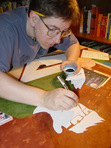Sue Clancy's Blog, page 28
September 28, 2019
Dr. Bob’s First Aid Kit is here!
They came in a big box. My early copies of the new print version of “Dr. Bob’s Emotional Repair Program First Aid Kit”! The official release of this book is November 1st – but you can click here for early access. I’ll be able to look at a print copy tonight while I brush my teeth – and that’s what I’d hoped for back when I started this project! But first – more happy dancing around the living room!
[image error]
For early access go here: https://store.bookbaby.com/bookshop/book/index.aspx?bookURL=Dr-Bobs-Emotional-Repair-Program-First-Aid-Kit1
September 23, 2019
the first aid cover art
Here’s the cover for the new print version of “Dr. Bob’s Emotional Repair Program First Aid Kit”. Keeping the hand-drawn look for the cover was important. Half of this book is filled with hand-drawn graphic-novel type stories. And the book originated in my sketchbook. So it seemed a no-brainer to keep the cover art “organic” looking. Here are both the front and back covers:
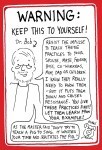
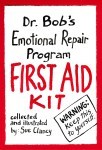
Yes, I did see this new print version as an opportunity to hand-write the entire book and considered it strongly. However from the outset of this project when we did the first printed editions small run, Dr. Bob Hoke wanted the book to be as easily accessible as possible – including constructing a book that would feel “simple” and even fun.
So as I designed this new print version I decided that typing the text of Dr. Bob’s lecture notes, rather than hand writing it would be more in keeping with Dr. Hoke’s methods. By typing I could also choose fonts and formats that would be easier for anyone, including dyslexics, to read. “Dr. Bob’s Emotional Repair Program First Aid Kit” is also small in size; 5.5 x 8.5 inches and only 56 pages long.
As I mentioned above, half the book is drawings… so I worked to make the cover art fit with the cartoon drawings inside the book.
“Dr. Bob’s Emotional Repair Program First Aid Kit” will be officially released November 1st – but since you follow my blog you can get early access here: https://store.bookbaby.com/bookshop/book/index.aspx?bookURL=Dr-Bobs-Emotional-Repair-Program-First-Aid-Kit1
September 17, 2019
the eggplant technique of creativity
“Feelings are guides not gods” is a phrase from “Dr. Bob’s Emotional Repair Program First Aid Kit”, the new print version I’m currently working on. The concept is illustrated by this story:
[image error]
Here’s some text from the book related to the artwork: “Do you think that feelings keep you from doing things? More good news – they don’t! We’ve all done many things we didn’t feel like doing – such as going to school or work when we didn’t feel like it – which proves that: Feelings don’t keep us from doing things. Moreover, when you do that thing you feel scared to do, you are nourishing your courage…… Remember, you are responsible for your feelings not responsible to them.” (see the Eggplant story above)
Cultivating and maintaining a high level of Emotional Intelligence is essential to well-being (and creativity). Good mental health is about more than just the absence of mental illness – it is the presence of good coping skills, being able to self-regulate, to see feelings as a guide whether the feelings are your own or someone else’s. (Btw: there’s a good article about teaching Emotional Intelligence here.)
I’ve found Dr. Bob’s concept of “feelings are guides not gods” applies to creativity, and the creative life, as well. Whether or not I feel a particular way doesn’t have to affect whether or not I make my artwork. My feelings are not a “god” to be obeyed. If it’s time to work in the studio, however short or long the time-to-work I’ve allotted is, off I go to my creative work no matter how happy, sad or inspired I feel at the moment.
Where I use my feelings as a “guide” is when I’m out in the world on the lookout for possible art-topics. I keep my inner eye open for things that capture my curiosity and my imagination. Then I keep a list of those things and my feelings related to them in my sketchbooks for future art-making. My use of this “feelings as guide” technique has helped me create many helpful guidebooks, so to speak, for my own creative life. I find it a sustainable creative practice.
All that aside I’d like to add that eggplant can, once in a while, be a very good vegetable – especially as eggplant parmesan.
September 10, 2019
the so-what art making technique
Recently I’ve been super busy with fine-art exhibits and other illustration projects. But now I’m back to regular work on a new print version of “Dr. Bob’s Emotional Repair Program First Aid Kit”. During my work on the pages about Dr. Bob’s S.W.I.F.T. finger therapy I remembered how valuable this concept is when I’m in the middle of an art project.
While a project is not a person all creative projects also have an ugly-duckling stage. A point in which they’re more “mess” than “masterpiece”. A point in which things are happening with the colors and shapes that may not be what I intended or hoped for.
I’ve found the S.W.I.F.T therapy helps me remember to calm down about the mess. If a creative person gets too angst-y about the in-progress project it stops the flow of creativity. Possibly leading to a creative block. Remembering to think of “So What If….” finger therapy helps me relax and to do nothing radical to the in-progress project during my don’t-like-it moment. It enables me to let go, and approach the project later with an open, playful, mind. Perhaps after lunch, perhaps the next day.
[image error]
Page from “Dr. Bob’s Emotional Repair Program First Aid Kit” collected and illustrated by Clancy
If you’ve just joined my blog (and thank you for that!) here’s the last post about this project. The last post covers another mental-health technique that relates, in my mind anyway, to living the sustainable creative life.
I began learning these mental-health techniques and applying them to my creative life back in the 1990’s. I’m still creating new artwork daily. Still loving it. Something works.
Hope this book and these posts will help you too. All the best…
September 3, 2019
A Readers World
For your amusement here is a collection of a few artworks in “A Readers World”, my one-person fine art exhibit opening Thursday, Sept 5 at Caplan Art Designs. http://www.caplanartdesigns.com/
I’m playing with the interconnectedness of life; the ways imaginative stories flow out into the readers world. And vice versa of course. Art can stir life. And life can stir art.
As I created these artworks, I thought of how a story is actions mixer. For example, each of these pieces contain ingredients from my experiences, the “actions” I’ve seen as I’ve lived my life, put into the cocktail shaker of my imagination.
Enjoy!
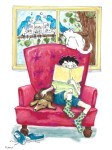
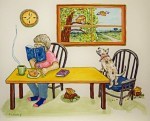
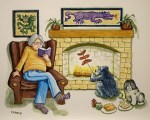
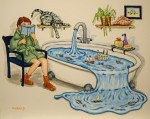
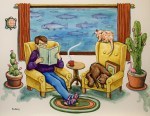
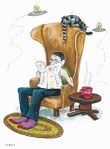
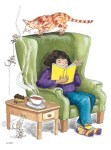
And yes, if you recognize aspects of a person, a pet, a place or a thing and wonder if…. the answer is probably “yes”! (It’s sort of like the “Easter Eggs” that can be found in some films.)
Anyway, if you look at some of my recent blog posts you can see more details of the ingredients of life that I mixed together to make each particular visual story.
Thanks for reading and (ahem) “reading”!
August 26, 2019
immortal good fortune
I’ve been busy getting ready for an exhibit at Caplan Art Designs (www.caplanartdesigns.com) that opens Sept 5th in Portland Or. This is one of the new art pieces that’ll go to the exhibit. Just put it in a new frame today. It’s titled “Immortal Good Fortune” (details below)
[image error]
“Immortal Good Fortune” by Clancy – 8 x 10 inches – gouache and ink on board
Here’s the series of random thoughts I was thinking about as I created it:
We make our own luck. When life hands you dragons – cook sausages to share with others. Dragons are often a symbol for self-confidence, good luck, happiness and power. Happiness is not about luck or getting what you want – it’s the state of mind when life gives us what we’re willing to accept.
And of course I was thinking about reading books, art collections and Schnauzer and Havanese dogs…
August 18, 2019
yarns heard around the world
I realized recently that the “bedtime story” ritual, for both children and adults, is nearly universal across cultures. While there is scientific evidence (see links here and here) that reading printed books before bed can help you sleep and provide other benefits – for me it’s plain indulgence. Naturally bedtime-reading is subject matter for one of my artworks that will be included in an upcoming exhibit in September at Caplan Art Designs:
[image error]
Yarns Heard Around The World – by Clancy – 8 x 10 inches – ink, gouache on board
For fun as I created this piece I combined my thoughts about bedtime reading with the concepts of teams and coaches…. counting sheep is a world-wide sport. Right? Lol!
August 10, 2019
the art technique of attention
I’ve been very busy getting ready for a one-person fine art exhibit at Caplan Art Designs that will open in September. (So my social media activity has slacked off lately.) Around the edges of creating new fine artwork, framing, paperwork and so forth I’ve been working towards a new print edition of “Dr. Bob’s Emotional Repair Program First Aid Kit”.
This story from the First Aid Kit has been a good reminder of an art technique I try to practice daily – even when I’m busy:
[image error]
Even when I’m very busy I practice taking a moment within my day, wherever I am, in the here-and-now and pay attention to my 5 senses. I try to let go of any preconceived conceptions, to just expand my awareness. I also include, in this exercise, paying attention to my free-associations and my imagination during my 5-senses check-in moment. I’ll note my sensory experience and “watch”, like you’d watch television, the memories, thoughts and associations that cross my mind as a result of the sensory experience. I’ll often make notes in my sketchbook.
What I “get” for my payment – when I pay attention – is the power to choose what to focus on when I’m at my art easel working.
This practice of paying attention to both sensory input and the content of my mind – is a version of what Betty Edwards wrote about in her book “Drawing On The Right Side Of The Brain” – in the section where she talks about chairs. How (and I’m paraphrasing) a drawing student first attempting to draw a chair will substitute their knowledge about chairs (4 legs, a square seat and back) and will draw a child-like symbol of a chair. One has to learn to see the shapes of the spaces around the chair as well as the shapes of the chair itself – what is actually seen (3 legs, a trapezoid shaped seat and back).
I find too often – especially when I’m busy – I’m substituting my “knowledge” about the world, my preconceptions, for what “is” in the world. So I find it helpful to practice seeing the shapes of spaces, so to speak, in my sensory experience of the world. And to see the shapes of spaces within my own mind.
Paying attention allows me to merge real-world phenomenon with my mental life and to choose to communicate, via art, in ways that are helpful, playful and fun.
Currently “Dr. Bob’s Emotional Repair Program First Aid Kit” only exists in e-book form. But as I said above, I’m working on that. This book has had such a profound impact on my own creative life that I want to have another print version around.
August 1, 2019
sea stories
I live now within a 2 hour drive from the Pacific Ocean. I also live near a river that feeds directly into the sea. So it’s been fun to read and think about stories, both fiction and non-fiction, that have to do with water. Books like: “The Old Man and the Sea” by Ernest Hemingway, “2000 Leagues Under The Sea” by Jules Verne, “Moby Dick” by Herman Melville, tales about pirates, books about the Lewis And Clark expedition and of course the writings of Mark Twain.
And I often see people reading printed books in town and on beaches along the coast. Their facial expressions make me wish I could see what story they were reading. What if a book being read leaked out from the readers mind and into the world beside them?
These musings led to my gouache painting titled “Sea Stories”:
[image error]
“Sea Stories” by Clancy – 8 x 10 inches – ink and gouache on board
July 25, 2019
feeding good wolves
I’ve been reading a book titled “Become America” by Eric Liu. In it Liu writes “To be a citizen is to be an artist…. ” Liu included examples of people imaging things like “why is this not a park?” and “How could these old folks and these little kids be making something together?”.
That got me thinking of how citizenship is an act of imagination. Governments, businesses – and of course artists – imagine all kinds of activities for their fellow citizens to participate in. Such imaginative action creates the civic world over time.
It is crucial, then, the kinds of imagination used and the intentions behind it. It matters which wolf gets fed: our good wolves or our bad ones. Or if you prefer angels: do we encourage the “better angels of our natures”?
It far too easy for the human mind to think “It’s always been this way” when we see civic spaces or events. It takes a healthy imagination and some effort to remember that we, collectively, created “this way” bit by bit and that we can maintain it or change it by equally small mundane bits too.
When it comes to my own imagination – and maintaining the health of it and my own civic engagement – I’m constantly asking myself “which wolf does this idea/thought/event feed?” and then looking for the small mundane steps needed to create a banquet, a meal or a snack for my good wolves and better angels.
One step I’ve identified recently, something small and within reach, that I can do to encourage and maintain my own healthy imagination – and good citizenship – is to create a new printed edition of Dr.Bob’s Emotional Repair Program First Aid Kit. And to make it more widely available.
Currently there is only the ebook version out. The first printed edition was done on an Espresso Book Machine at my local Powell’s bookstore. That machine no longer exists. Sigh. Theoretically copies of the first printed edition may still be found out in the wide world – by clicking here – but it’s a challenge. I want to make the book easier to find.
I, personally, want to have another printed copy of Dr. Bob’s Emotional Repair Program First Aid Kit. I want to put a copy in my bathroom. I want to read it when I brush my teeth. I want my good wolves to have more food to sink their teeth into. I want to maintain my healthy imagination – and to practice envisioning other good wolves with healthy imaginations also brushing their teeth…
Anyway, here’s one of my illustrations for the book:
[image error]
illustration by Sue Clancy for “Dr. Bob’s Emotional Repair Program First Aid Kit

